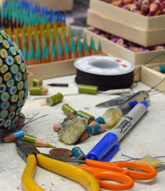ARTIST'S STATEMENT
To make the pencil sculptures, I take hundreds of pencils, cut them into 1-inch sections, drill a hole in each section (to turn them into beads), sharpen them all and sew them together. The beading technique I rely on most is peyote stitch.
I'm inspired by animals, plants, other art, Ernst Haeckel, Odilon Redon, mythology. In fact, it isn't easy to specify particular sources of inspiration. Sometimes one sculpture will inspire the next, or maybe I'll make a mistake, and that will send me off in a new direction.
I started off in the direction of prickly things when I was in my last year at Mass College of Art. It all comes from one idea I had for a box with a secret compartment that would contain a pearl. The box would be shaped like a sea urchin, made of silver. In order to open the box and reveal the secret compartment, you'd have to pull on one of the urchin's spines. The idea was of something beautiful, sculptural, but that you wouldn't necessarily want to touch, and that also held a secret treasure. I never developed the small-metals skills to ever make the box, but it got me thinking about that kind of form. I started experimenting with different materials to make urchin forms. I found that nails, pushed through window screen, worked well, and I could use many different types and textures and colors of nails.
After graduation, I didn't have the facilities to do glass, so I kept playing with the nails and screen (very low tech), and gradually started working larger, adding zippers and other elements. Continuing with the container theme, I started making the tack-coated eggs to place inside the nail baskets.
The eggs were so beautiful on their own, as well, that I decided to open some of them up, putting little windows in, for example.
While I was doing that work, I was also dabbling in bead work. I taught myself several beading techniques, especially peyote stitch, which is great for creating sculptural work.
I was constrained a bit with the nails, because I couldn't get all the turns and twists I wanted. I loved the textures and the contrast between the industrial qualities of the nails and the organic forms of the sculptures, but I wanted more complex forms. I was also thinking about how bad the liquid rubber probably was for my health.
So, I experimented with other pointy things and techniques, and finally hit on turning pencils into beads and sewing them together. Using this combination of technique and materials allows me to retain all the qualities that I want in my work, with the potential for more variety of form.
Copyright © 2014 Jennifer Maestre
